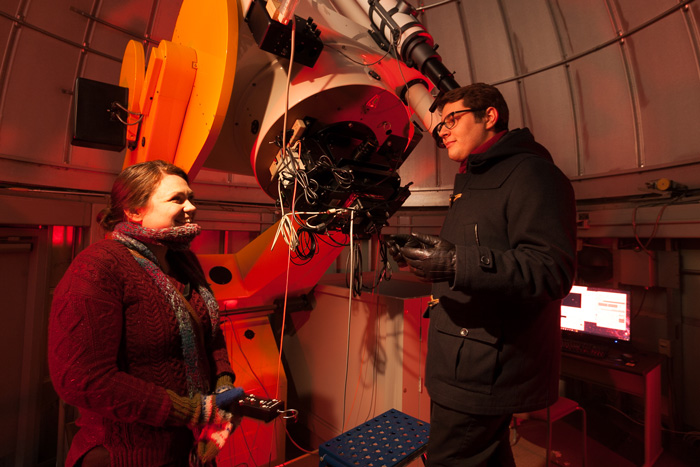A Screaming Comes Across the Sky

Visiting Assistant Professor of Physics & Astronomy Laura Watson and Aidan Pidgeon '20 spend some time in a chilly Britton Observatory. Photo by Carl Socolow '77.
Dickinson astronomers team with University College London to track the 7 Iris asteroid
by Tony Moore
Aidan Pidgeon '20 (physics) gets pretty excited about things related to space and astronomy. According to his Facebook bio, he "Screams at rocket launches like you do at the Super Bowl." But this semester, Pidgeon was doing more than screaming at a fiery liftoff, as he and Visiting Assistant Professor of Physics & Astronomy Laura Watson looked to the stars for their own discoveries, through an Introductory Astrophysics project.
The research project centered on a celestial body called 7 Iris, a 200-kilometer-long hunk of rock in the asteroid belt orbiting the Sun between Mars and Jupiter. On campus, Pidgeon, Watson and a team of students—Adam Gamber '20, Angie Minot '20, Amanda Baylor '20, Henry Foresman '20, Ming-Hua Chang 20, Olivia Young '20 and Zifan Lu '18—aimed Dickinson’s Britton Observatory telescope at 7 Iris’s known coordinates. Across the globe in Europe, at University College London (UCL), another team of student astronomers did the same. They were looking to pin down the asteroid’s distance from Earth and velocity, measuring it against stars that were in the background (the distance wouldn't be discernable if just one telescope were aimed at it).
“This is the single most interesting assignment I had all semester, but it really didn't feel like an assignment,” says Pidgeon, who studied the position and motion of the asteroid and took photos through the telescope. “I've plugged in all these data and typed in something like 500 numbers to a spreadsheet. And then I see the plot of this, and it's perfect, and it's like wow, we actually did this and got this data and found a result that's real and tangible. It was just incredible.”
The calculations—once other team members cleaned the images of thermal and other noise—revealed that 7 Iris is traveling at 6 kilometers per second, perpendicular to our line of sight, or about 3.84 miles per second. “It was exactly what we expected,” says Pidgeon, who notes that 7 Iris is accelerating at a rate of 2.5 centimeters per second per second. “When we looked up the known value for this asteroid's motion, we had less than 1 percent error in our calculations.”
Keep in mind that these observations were made at a distance of around 90 million miles away, about the same distance between the Earth and the Sun.
“We were pretty excited to get that level of precision,” says Watson, who earned her master’s degree at UCL. “Students learn the tools of the trade in theory, but of course it's nice for them to actually implement them and see how these things work. They’ve learned how to operate the telescope, work with celestial coordinates, and do data reduction and analysis. I got a lot of exposure to this stuff really early on in my undergrad, and I wanted to give these guys a chance to experience those things too.”
For Pidgeon, early exposure to this type of experimentation is foundational for what he sees himself doing going forward.
“Being able to work with these tools at such an early point—in what’s essentially the introductory class—it was wonderful,” he says. “As a sophomore, getting the chance to learn how to do research like this was really amazing. And it's a big advantage knowing how to use these tools, in terms of summer research projects and internships.”
TAKE THE NEXT STEPS
Published January 11, 2018